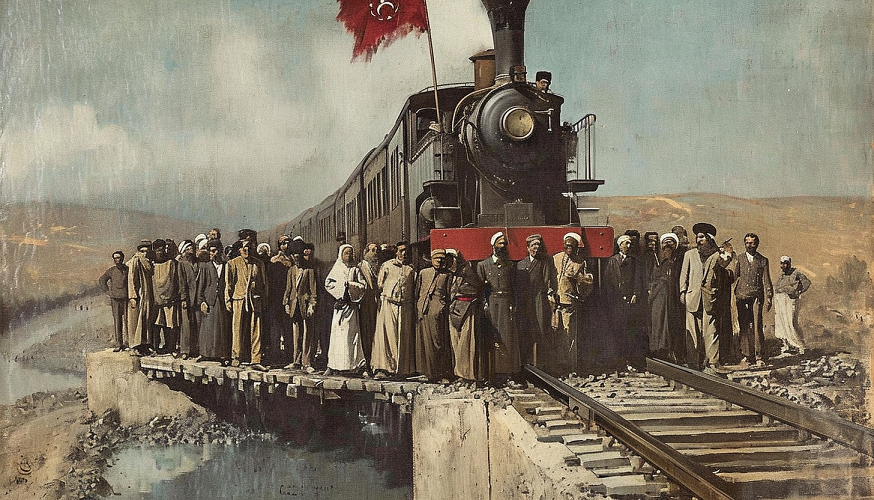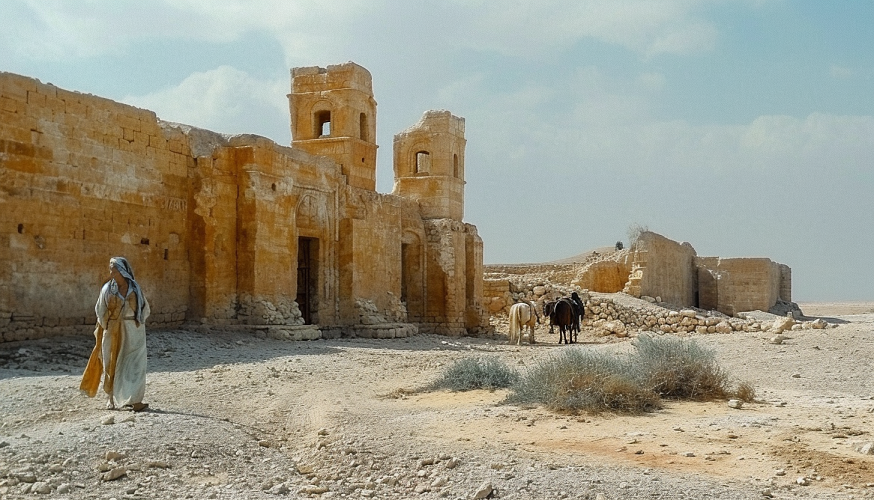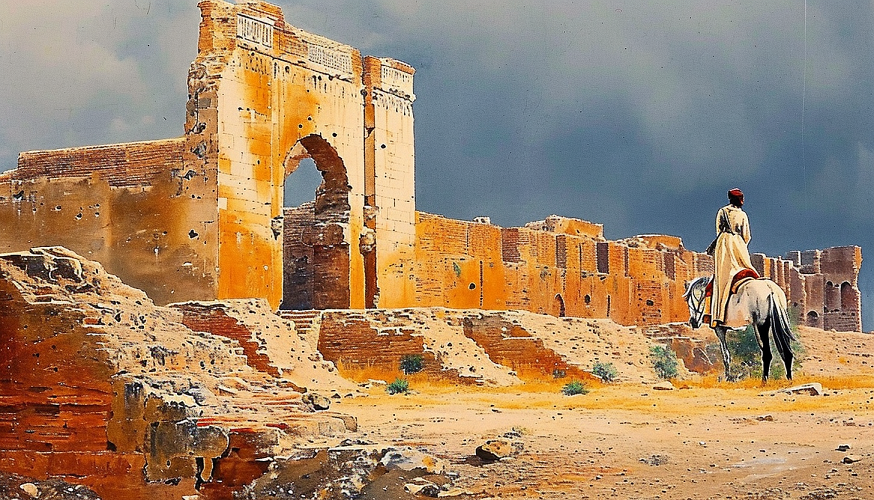In her exploration of the desert landscapes chronicled in “The Desert and the Sown” by British traveler and writer Gertrude Bell, we delve into a captivating narrative that unfolds against the backdrop of both historical relics and the profound intricacies of Bedouin culture. As Bell embarks on her journey she encounters a world where the clash between the ancient and the modern becomes increasingly evident. Through keen observations of cultural nuances, and the rich tradition of Arab storytelling, Bell encapsulates the essence of her immersive exploration and the invaluable insights gained from her travels through the Jordanian deserts.
Bypassing Mshatta
Accompanied by local tribal guides, Gablan and Namrud, her journey commenced with a poignant moment as the hoofs of their mares clinked against the metals of the Hajj railway, marking a transition from the familiar to the realms of the unexplored desert. The direction chosen was east by north, a route meticulously planned to leave Mshatta slightly to the south. Once known for its splendid walls and architectural marvel, Mshatta now stood as a relic overshadowed by the unrelenting march of modernity symbolised by the nearby railway. Bell’s decision to bypass Mshatta was a homage to its former glory, acknowledging that the scars of time and human intervention had rendered it a shadow of its past.
Therefore let those who saw it when it yet stood unimpaired, cherish its memory with gratitude, and without too deep a regret.
Gertrude Bell: The desert and the Sown 1907
The proximity of the railway to Mshatta , a site of historical significance, served as a poignant reminder of the inevitable clash between the ancient and the modern. Bell pondered over the act of vandalism that had stripped Mshatta of its former glory. While acknowledging the practical reasons behind such an act—neither the Syrian fellah nor the Turkish soldier could resist repurposing the walls for practical uses—Bell couldn’t help but feel a sense of loss for the once magnificent structure.

Political and Military Insights
In the midst of Bell’s journey, a chance encounter with two soldiers offered a profound insight into the political and military undercurrents shaping the region. These soldiers, who had fled from the battlefield, recounted tales of conflict involving significant figures: Ibn Rashid and Ibn Sa’ud. Their narrative provided Bell with a firsthand account of a pivotal agreement that had far-reaching implications for the balance of power in the region.
They had formed part, so they affirmed, of the troops that the Sultan had despatched from Baghdad to help Ibn er Rashid against Ibn Sa’oud. They related how the latter had driven them back step by step to the very gates of Hail, Ibn er Rashid’s capital, and how as the two armies lay facing one another Ibn Sa’oud with a few followers had ridden up to his enemy’s tent and laid his hand upon the tent pole so that the prince of the Shammar had no choice but to let him enter. And then and there they had come to an agreement.
Gertrude Bell: The desert and the Sown 1907
The agreement detailed by the soldiers revealed that Ibn Rashid had relinquished control over vast territories, retaining only the city of Hail and its northern lands, including Jawf. In return, Ibn Sa’ud’s sovereignty over Riyadh and its extended fief was recognised. This territorial shift was a significant alteration in the geopolitical landscape, reshaping allegiances and power dynamics in the Middle East.
Bell reflected on the authenticity of this account, considering it the most reliable information she had received from Nejd. This revelation underscored the volatile and ever-changing nature of political alliances and conflicts in the desert landscape. Further, Bell’s interactions with the Arabs regarding Ibn Rashid painted a picture of a complex character – perceived as both shrewd and mad, intelligent but perhaps lacking the necessary harshness to enforce authority over the tribes.
“Shatir jiddan,” they would say ; ” he is very shrewd,” but alter a moment they would add, “majnun” (“but mad”). A reckless man and a hot-headed, so I read him, with a restless intelligence and little judgement, not strong enough, and perhaps not cruel enough, to “enforce his authority over the unruly tribes whom his uncle, Muhammad, held in a leash ol fear, and too proud, if the desert judges him rightly, to accept the terms of the existing peace.
Gertrude Bell: The desert and the Sown 1907
Cultural Observations
As Bell continued her journey, her keen eye for cultural nuances became evident. One of the most striking aspects he noted was the rich and detailed nomenclature of the Arab landscape. Every mile traversed brought with it a new name, a testament to the deep connection the Arab people had with their land. This abundance of names was a reflection of a culture that found identity and meaning in the very contours of its terrain. Bell was struck by the precision with which the Arabs could locate and describe places in what appeared to the uninitiated as a featureless desert.
If you ask where a certain sheikh has pitched his tents you will at once be given an exact answer. The map is blank, and when you reach the encampment the landscape is blank also.
Gertrude Bell: The desert and the Sown 1907
This attention to the landscape’s nomenclature echoed in the pre-Islamic poetry, rich with references to specific places, and continued in the oral traditions of storytelling and historical recounting. Bell understood that these names were carriers of stories, history, and the collective memory of a people deeply intertwined with their environment.
Ride with an Arab and you shall realise why the pre-Mohammadan poems are so full of names, and also how vain a labour it would be to attempt to assign a definite spot to the greater number of them, for the same name recurs hundreds of times.
Gertrude Bell: The desert and the Sown 1907
Storytelling in Transit
As they journeyed through the desert, Bell was introduced to the rich tradition of Arab storytelling by her companion, Namrud. One tale, in particular, stood out, encapsulating the deep-seated values and social norms of the Arab culture. It was a story of hospitality, honour, and the consequences of betrayal, themes that resonated deeply in the fabric of Arab society.
The tale revolved around a man who, having lost everything to a blood feud, sought refuge and protection under the hospitality of a sheikh from a neutral tribe. The sheikh’s benevolence was repaid years later when, facing misfortune himself, he sought help from the man he once aided.
He went to the sheikh’s tent and laid his hand on the tent pole and said : ‘ Oh sheikh ! I am your guest ’ Ana dakhlak,’ (the phrase of one who seeks for hospitality and protection).” And the sheikh rose and led him in and seated him by the hearth, and treated him with kindness. And he gave him sheep and a few camels and cloth for a tent, and the man went away and prospered so that in ten years he was again as rich as before.
Gertrude Bell: The desert and the Sown 1907
The story took a poignant turn as the sheikh, now destitute, was received not with the expected honour but with indifference by the man’s son, highlighting a lapse in the traditional codes of hospitality and respect:
Now when he reached the tents the man was away, but his son was within. And the sheikh laid his hand on the tent pole, and said, ‘ Ana dakhllak,’and the man’s son answered . ‘ I do not know you, but since you claim our protection, come in and my mother will make you coffee.’ So the sheikh came in, and the woman called him to her hearth and made him coffee, and it is an indignity among the Arabs that the coffee should be made by the women.
Gertrude Bell: The desert and the Sown 1907
This narrative was a reflection of the moral landscape of the Arab world, where hospitality was not merely a courtesy but a sacred duty, and betrayal of such a duty was a grave dishonour. The significance of this story, as recounted by Namrud, lay in its rarity, indicating that such breaches of hospitality were exceptional and thus memorable.
Archaeological Exploration
Bell’s journey led her to the exploration of historical sites, shedding light on the rich and varied history of the region. One significant discovery was the semi-circular hills that housed the tents of Fellah ul Tsahad. This location was a strategic point, nestled in the arms of the hills, and served as a vivid example of how the geography of the region influenced its settlement patterns.
The ruins on the Jebel el ’Alya particularly caught Bell’s attention. These ruins, strewn across the rolling uplands, hinted at a past where they likely served as forts guarding a frontier. The first ruin explored, possibly the Kasr el Ahla, stood as a testament to the region’s historical military significance. Bell’s observations suggested that these forts could have been part of the Ghassanid defence line, although the lack of inscriptions left room for conjecture.
Further exploration led Bell to a large tank, meticulously constructed of dressed stones, a relic that spoke of a sophisticated understanding of water management in an arid landscape. The nearby ruins of El Muwaggar indicated the presence of a military post, devoid of the trappings of a civilian settlement, further underscoring the strategic importance of these sites.
The discovery of what the Arabs believed to be a stable, designed akin to a church with parallel chambers, offered a unique glimpse into the architectural styles of the period. The presence of holes for tethering ropes suggested its use for housing horses, a critical asset in the desert landscape. These ruins, with their barrel vaults and Corinthian-influenced designs, painted a picture of a region that was once a crossroads of cultures and architectural influences.

Bedouin Herbalism
As Bell continued her exploration, she encountered more ruins, such as Najereh, Kharaneh, and Umm er Resas, each offering a glimpse into the region’s rich past. These heaped mounds of cut stones, known locally as “rujm“, prompted Bell to ponder the extent of past habitation in the desert and the civilizations that once thrived there.
This part of the journey was also an educational experience, as Bell’s companion Gablan took on the role of a teacher. He introduced Bell to the diverse flora of the desert, explaining the practical uses of each plant. The utrufan leaves were used to scent butter, the prickly kursa’aneh for salads, the billan and shih plants as fodder for camels and sheep, and the ashes of the gali plant in soap making. These details highlighted the ingenious ways in which the local population adapted to and utilised their harsh environment.
Through her encounters, Gertrude Bell’s expedition transformed into an exhaustive exploration of the Jordanian deserts’ environmental, botanical, and societal textures. The knowledge she gained during this segment of her travels deepened her comprehension of the area, infusing her journey with added dimensions of cultural and ecological insight. This rich tapestry of learning is carefully documented in Gertrude Bell’s books, enhancing our appreciation of her explorations and her contributions to our understanding of the Middle Eastern landscape.

